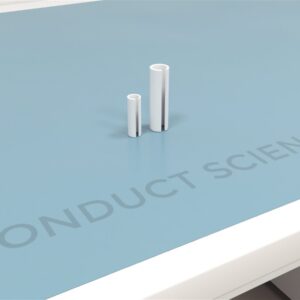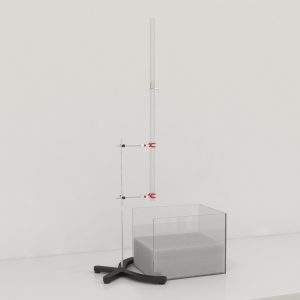$3,899.00
The Small Animal Ventilator is a high-quality device designed for precise and controlled ventilation of small laboratory animals during anesthesia. It offers adjustable ventilation parameters and features a user-friendly interface for easy monitoring. With its compact design and safety features, it is an essential tool for researchers conducting respiratory studies in the life sciences field.
Our Small Animal Ventilator is used to assist or control the breathing of small animals such as rats and mice in research and veterinary settings. These ventilators are designed to provide precise and controlled ventilation to the animal, typically by delivering a mixture of oxygen and other gases to the lungs.

RWD is a global leader in the design and manufacturing of advanced research and laboratory equipment. Specializing in high-precision instruments for neuroscience, behavioral science, and pharmacology.



bool(false)
Mechanical ventilators are used to support or replace spontaneous breathing in patients and animals suffering from inadequate respiratory functions. Ventilators are also often used as part of long-term anesthesia procedures, due to the depression of the respiratory system by certain anesthesia agents, and when neuromuscular blocking (NMB) agents are used. Mechanical ventilators are selected based on the size and weight of the animal. Ventilators retired from human use are usually reutilized for laboratory animals. For small animals, such as rats and mice, neonatal ventilators can be used since they can deliver smaller, more precise volumes and pressures.
Despite their life-saving application, mechanical ventilators come with their associated risks and complications. Mechanical ventilators have the potential to cause lung injury referred to as ventilator-induced lung injury (VILI), leading to the rapid type of disuse atrophy in respiratory-related muscles, barotrauma, and impairment of mucociliary motility in the airways, among other complications. The interest in the risks and complications arising from ventilator use and the relationship between ventilator settings and certain biological responses has allowed the discovery of four mechanisms involved in ventilator-induced lung injury. VILI can result from the application of a local pressure that forces cells and tissues to acquire an unnatural shape (regional overdistension), the repeated recruitment and de-recruitment of the unstable lung causing epithelial airspace lining abrasion by interfacial forces (low-volume injury), large alveolar surface area oscillations associated with surfactant aggregate conversion (inactivation of surfactant) and interdependence mechanisms that raise cell and tissue stress between neighboring structures with differing mechanical properties.
A retrospective cohort study of 97 United States intensive care units (ICU) from 2005 to 2007 led to the observation that at any given hour the mean percentage of ICU patients receiving mechanical ventilation was 39.5% (± 15.2%). Further, the study also found that at least an average of 29.0% (± 15.9%) of ICU patients relied on a ventilator (Wunsch et al., 2013). Assisted ventilation also plays an important role in the survival of preterm newborns and infants born with respiratory diseases. In comparison to adults, the sensitivity of lung tissues and the small volume of the lungs of neonates and infants serve additional challenges and complications associated with mechanical ventilation. Additionally, mechanical ventilation in this group raises their risk of developing long-term clinical complications that include chronic lung disease, pulmonary hypertension, prolonged supplemental oxygen constraint, nutritional issues, and developmental delay. Given their life-saving application, constant research and development of mechanical ventilators are needed to understand their associated risks and complications.
Animal models provide a practical means to investigate the risks and complications of assisted ventilation using mechanical ventilators. Among the animal models of lung injury and airway diseases, the rodent models have seen the greatest popularity. This popularity is mostly due to their accessibility and their well-described respiratory functions. In comparison to larger animals, the rodents offer lower husbandry costs, faster regeneration, and shorter breeding cycles. The availability of transgenic animals also makes them an enticing option for research of lung diseases. Further, mechanical ventilators are often a part of many animal-based types of research that require surgery.
ConductScience offers two ventilator options, both available in sizes small and medium (For large animal ventilators click here). The small-sized ventilator is recommended for small mice, whereas the medium-sized ventilator is suited for small mammals such as rodents, hamsters, rabbits, felines, and canines weighing under five kilograms.
Conduct Science’s VentStar small animal ventilator is a compact, small ventilator with a 7-inch LCD touchscreen. It comprises an intelligent system that allows storage and recollection of up to 10 parameters, real-time display of pressure-time graph in volume and pressure modes, automatic setting of reference breathing parameters on entering the animal weight, and alarm alerts. Other specifications and features are as follows.
| Respiration Rate | : Switchable between 10 to 300 rpm |
|---|---|
| Tidal Volume Range | : 0.05 ml to 5 ml |
| Airway Pressure Range | : 1 to 50 cm water (accuracy range ± 0.7 cm water) |
| Positive End Expiratory Pressure (PEEP) Range | : 0 to 10 cm water |
| Modes | : Volume and Pressure modes available |
| Inspiration: Expiration (I: E) Ratio | : Adjustable range of 20% to 80%. The plateau pressure increases the tidal volume from 0 to 20% and can set auto-peep once after every 10 to 999 breaths or manual control. |
| Other | : Provides safe and effective intermittent positive pressure ventilation (IPPV) and setting of the respiratory parameters such as PIP/PEEP/Plateau Pressure/INSP.Hold/EXP. Hold. |
The other available mechanical ventilator comes with two interchangeable piston assemblies: a large piston and a smaller piston. The large piston has a tidal volume of 3 to 30 cc (increments of 3 cc), and the smaller piston offers a tidal volume of 0.5 to 5 cc (increments of 0.5 cc). Other features include controllable Positive End Expiratory Pressure (PEEP), respiratory rate of 18 to 150 breaths/min, and adjustable volume and rate.
As opposed to manual ventilation, mechanical ventilators allow the precise control of the duration of inspiration and expiration, the volume of gas delivered to the lungs and the pressure reached in the airway during inspiration. Ventilators achieve controlled ventilation by application of intermittent positive pressure to the airway, which can be accomplished by directly delivering gas to the anesthetic breathing system or indirectly by compressing a rebreathing bag or bellows.
The first step of ventilating an animal involves the calculation of the required tidal volume (approximately 7 to 10 ml/kg body weight) and the selection of the respiratory rate. Generally, the rate is selected slightly lower than the normal resting rate of the animal when it’s conscious. In case the ventilator does not have direct settings for tidal volume and respiratory rate then it is most likely to have settings for inspiratory time and inspiratory flow rate. The calculations can be based on the following equations,
Further, some ventilators may only provide controls for inspiratory time and inspiratory: expiratory (I: E) ratio. The ratio is usually set to 1:2, however, a ratio of 1:3 and 1:4 can also be used without causing significant cardiac depression while maintaining inflation pressures below 20 cm water. Apart from these variables, maximum inspiratory pressure should also be set on the ventilator at less than 15 cm water for small animals and not more than 25 cm water for large animals, under most circumstances.
Mechanical ventilation in animals is often used in research that requires long-term use of anesthesia or when neuromuscular blocking agents are used. However, the use of ventilators has also been extended to the research of ventilator-induced lung injuries and for understanding the relationship between ventilator settings and certain biological responses. Regardless of the purpose, controlling ventilation relies on the use of an endotracheal tube or the placement of a tracheal cannula if the animal is not intended to recover. These methods prove successful in comparison to using a face mask, which risks the inflation of the stomach, and laryngeal masks. Once the tube or cannula is placed, it is connected to the ventilator to allow mechanical ventilation.
Prior to beginning the procedures of mechanical ventilation, it should be ensured that all the equipment and instruments used are thoroughly cleaned. The subject must be adequately and appropriately anesthetized before and during the entirety of the procedure to ensure humane treatment.
Endotracheal Intubation
Endotracheal intubation is assisted by a laryngoscope. The type of endotracheal tube and laryngoscope (Miller laryngoscope and Macintosh laryngoscope) used are dependent on the size and weight of the subject. An appropriate length for an endotracheal tube is usually measured to be the approximate distance from the external nares to just anterior to the thoracic inlet. An uncuffed endotracheal tube is preferred for small animals. The tubes should be lubricated with a small quantity of lidocaine gel to allow easy passage. Further, cough and swallowing reflexes should be adequately numbed. It is recommended that the animal is administered with oxygen for about 2 minutes before being intubated to slow the advent of hypoxia should the larynx be obstructed. The detailed methodology of endotracheal intubation of different animals can be found here.
The procedure of insertion of the endotracheal tube is performed by resting the animal on its back (generally), with the neck and head flexed. The laryngoscope is then advanced over the tongue towards the pharynx. Care must be taken to extend the tongue and avoid damaging the surface of the teeth of the animal. Following successful laryngoscopy, the endotracheal tube is advanced into the trachea.
Performing Laryngoscopy Using Miller Blades
Tracheostomy
Evaluation of effects of various modes of ventilation
Pecchiari et al. evaluated whether the detrimental effect of mechanical ventilation was dependent on the mode of mechanical ventilation. For their study, they used healthy male Sprague-Dawley rats that were premedicated with diazepam and anesthetized with pentobarbital sodium and chloral hydrate via intraperitoneal injection. Ventilation was performed through tracheal cannulation and a balloon-tipped catheter was placed in the lower third of the esophagus. After 10 minutes of spontaneous ventilation, animals were divided into 4 groups (8 animals were euthanized to serve as controls); spontaneous ventilation (SV), positive pressure mechanical ventilation (PPMV), negative pressure mechanical ventilation-whole body (NPWBMV), and negative pressure mechanical ventilation-thorax only (NPTOMV). After 4 hours of ventilation, lung mechanics, cytokines concentration in serum, bronchoalveolar lavage fluid, lung wet-to-dry ratio, and histology were assessed. The results showed that PPMV and NPWBMV modes were similar in effects to SV. Further, NPTOMV resulted in significant chest and lung distortion, a reversible increase of lung elastance, and higher polymorphonuclear leucocyte count and cytokine levels. Overall, in terms of lung mechanics, histology, and wet-to-dry ratio, no evidence of mechanical ventilation–dependent lung injury was found during ventilation performed with tidal volumes and timing of spontaneous, quiet breathing in the groups.
Assessment of the effect of variability of breath rate and tidal volume in the setting of acute lung injury
Arold et al. speculated if the improvement of arterial oxygen tension during mechanical ventilation occurs over a specific range of variability of breath rate and tidal volume. For their experiment, male Hartley guinea pigs with endotoxin-induced lung injury were tracheally cannulated for mechanical ventilation. Initially, all subjects were ventilated on room air at 60 breaths/min, constant flow inspiration, tidal volume (VT) 5.1 ml/kg, I: E ratio of 1, PEEP 3 cm H2O, and fractional inspiratory oxygen (FIO2) of 0.22. Following this, subjects were divided into two groups. Group 1 underwent 30 minutes of control period with conventional volume-cycled ventilation (CVV), which was followed by 30 minutes of variable ventilation (VV) with different tidal volume distributions (random sequence of values taken from a uniform probability distribution falling between ± 0, 10, 20, 40, or 60% of the mean VT). Group 2 underwent only CVV for 3 hours. Arold et al. were able to find that VV improved lung mechanics at every degree of variability and significant oxygenation occurred at 40% variability of VT. Comparison of data between Group 1 and 2 revealed that specific ventilation mode, and not the duration of ventilation, contributed to the changes in lung mechanics and blood oxygenation.
Investigation of the effects of high-tidal-volume ventilation in the infant mouse
An in-vivo infant mouse model was utilized to investigate the effects of high tidal volume (VT) on lung mechanical parameters and lung injury. Two-week-old specific-pathogen-free female BALB/c mice were ventilated with either high VT with zero end-expiratory pressure (HVZ), high VT with positive end-expiratory pressure (PEEP) (HVP), or low VT with PEEP. Mice received ventilation for 60 minutes during which thoracic gas volume (TGV) and respiratory system impedance (Zrs) was measured at baseline and for every 10 minutes. At the end of the study blood samples and bronchoalveolar lavage fluid (BALF) were also collected. It was observed that the HVZ group showed a significant reduction in TGV after 20 min of mechanical ventilation, which remained constant throughout the investigation. The investigation concluded the loss of lung volume could be attributed to alterations of respiratory mechanics during VT without PEEP and that although PEEP during high VT ventilation prevents atelectasis, it induces lung injury. (Cannizzaro et al., 2008)
Investigation of short-term effects of hyperoxia on respiratory mechanics
Cannizzaro et al. investigated the impact of supplemental oxygen in mechanically ventilated adult (8-week old) and infant (2-week old) mice. For their experiment, eight and two-week-old female BALB/c mice underwent a tracheotomy, and the trachea was cannulated. Adult mice were ventilated with room air with a respiratory rate (RR) of 300/min with PEEP of 3 cm H2O and target VT of 10 mL/kg resulting in 7.3 ± 0.13 mL/kg delivered VT. As for infant mice (ventilated using room air), ventilation parameters were RR of 240/min with PEEP of 3 cm H2O, and a target VT of 15 mL/kg (delivered VT of 8.8 ± 0.48 mL/kg). Both groups were exposed to inspired oxygen fractions (FIO2) of 0.21, 0.3, 0.6, and 1.0 during 120 minutes of mechanical ventilation. No differences in airway resistance were found in the different FIO2 groups using the low-frequency forced oscillation technique when corrected for changes in gas viscosity. Further, similar changes over time in both age groups were observed in coefficients of lung tissue damping, and elastance, and no difference in inflammatory responses between the age groups was observed.
Investigation of the influence of recruitment maneuvers on lung mechanics
To determine the influence of recruitment maneuvers (RMs) on lung mechanics and their possible role in producing lung injury, 8-week old healthy female BALB/c mice either received positive end-expiratory pressure (PEEP) at 2 or 6 cm H2O and volume- (20 or 40 mL/kg) or pressure-controlled (25 cm H2O) RMs every 5 or 75 min for 150 minutes. Based on the data obtained it was observed that frequent application of inflation maneuvers (IMs) atop of elevated PEEP levels did not cause lung injury after short-term ventilation with low VT. Further, it was also observed that an increase in PEEP (without the use of IMs) and the application of IMs produced peak airway opening pressure below 25 cmH2O that did not prevent or reverse changes in lung mechanics. (Cannizzaro et al., 2009)
Strengths
Mechanical ventilators play an important role in the survival of those suffering from respiratory issues. In clinical practices, a single device for mechanical ventilation makes the technical features of the ventilation procedure simple. The device mitigates the need for a separate piece of equipment and the hassle of shifting the subject during the experiment as seen with manual devices. Further, mechanical ventilators allow researchers to regulate the volume and respiratory rate along with control of the positive end-expiratory pressure (PEEP). The programmability of mechanical ventilators also helps guarantee the standardization of protocol and repetition of the procedure between subjects; This capability helps reduce ambiguity in research and promotes the accuracy of results. The diversity in sizes of the mechanical ventilators permits researchers to conduct research on animals of different weights and sizes without any restrictions.
Limitations
As with any equipment, the mechanical ventilator must be monitored to avoid any issues that can arise during assisted ventilation. It is important that breathing motion and lung volume are monitored throughout the various stages of the breathing cycle. Prolonged ventilation may affect the survivability of the subject. In the field of mechanical ventilator-based research, the need of age-specific model is necessary. Additionally, extrapolating the research results to other animals of different ages or species has its limitations. The size of the subject may also present researchers with some technical difficulties in extracting and analyzing blood gas samples.
| Weight | 14.33 lbs |
|---|---|
| Dimensions | 28 × 47 × 33 cm |
| Brand | RWD |
| Device Type | Inhalation Anesthesia, Veterinary Inhalant Anesthesia |
| Volts | 110V, 220V |
You must be logged in to post a review.
There are no questions yet. Be the first to ask a question about this product.
Reviews
There are no reviews yet.